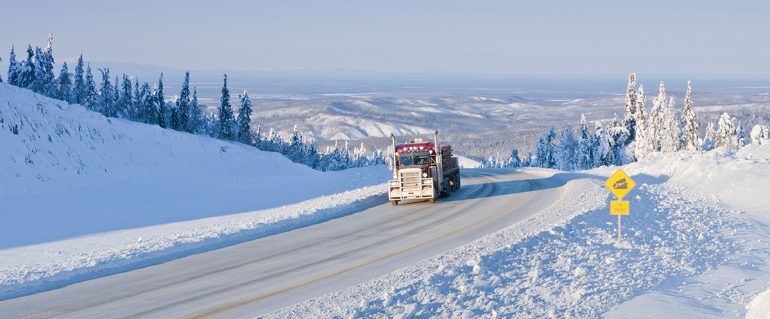Real Ice Road Truckers
Before we get too deep into the work that gets done on an ice road, what even is an “ice road” and why would you need one?
In winter in remote areas of Northern Canada and Alaska, the temperature drops down far enough that area lakes and rivers freeze over. Early in the season, ice thickness is measured by the Department of Transportation (DOT) with ice augurs and even hand boring tools. As the winter season progresses, ice thickness increases and is measured with high-tech subsurface radar technology. The DOT plans safe transportation routes on the ice to connect isolated areas that are usually only reachable via small planes. Bringing in food, supplies, fuel and large construction equipment by truck is much cheaper than by air. Another reason ice roads are critical to this area is often the goods the trucks are hauling are too heavy to be flown in small planes. Large freight is flown in to a transportation hub, then shipped on ice roads by truck to the final destination. At Alaska Air Freight, we can work with providers using ice roads to transport goods as part of our door-to-door rural Alaska services.
Once the network of frozen roads are ready, amphibious vehicles run light-weight test runs to check for weak spots. Once the routes are approved, the all clear is given and trucks can begin driving. Even with the cost of planning and developing the ice roads, they are still significantly cheaper than permanent infrastructure of roads and bridges. One estimate set it at 200-300 times less expensive ($1 million vs $200-$300 million). Also, ice roads should be kept clear of large amounts of snow because the ice remains frozen when it is exposed to the below-freezing air temperatures. Snow acts as an insulator effecting ice levels and encourages melting, so maintenance is important on ice roads.
Enter The Ice Road Trucker. They play an integral role in the transportation of goods to the far reaches of Alaska and Canada. They aren't all like the Ice Road Trucker show you may have seen on tv, though. Those drama filled episodes of reality tv can be heavily edited for the audience's benefit. This program, in particular, is notorious for having a script and even allegedly re-enacting some of the more dramatic scenes. They play an integral role in the transportation of goods to the far reaches of Alaska and Canada.
What is like to drive on a road made of ice? Truthfully, it’s cold, lonely and dangerous. Even though the road is ok’d for travel, that doesn’t mean it’s a Sunday drive to Grandma’s. Speed limits are often set at about 20 mph, which is pretty slow going, making for long hours. It can be a long distance between services (gas/food) and they are mostly in the dark. Even cell phone service is scarce, though some find luck with satellite phones. some pretty long distances between services. With such a desolate route, it is imperative that the driver can maintain focus for hours and knows how to maintain their truck in the brutal weather conditions. It is likely that they will have to manage issues on their own. Mechanical breakdowns due to the cold temps can happen at any time and there usually isn't immediate help in many areas of the routes. In this extreme cold, being outside for prolonged periods of time can result in injuries and death. So, it is important to know your stuff when it comes to your gear. Driving on the ice roads can be unpredictable but serves a great purpose (getting much needed goods and equipment to remote areas) as well and can be very rewarding.
Why would anyone signup for this job? In short, the money. Ice Road Truckers can make a year’s salary as a regular over the road trucker in about 3 months working as an Ice Road Trucker. That’s right, great money for a short period of grueling conditions is the main draw to this type of work. There are a number of shipping companies in this area and also many off-road companies that tow smaller loads such as vehicles. No matter what size vehicle you are driving, experience is important if you want to be an ice road truck driver. Having driven on icy routes before can help find a job, but often times, finding this lucrative position is all about who you know in the industry too.






